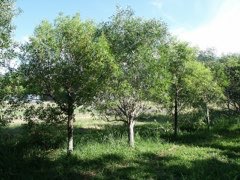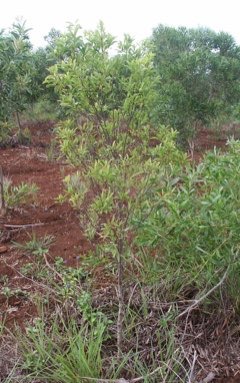 |
|
Denis.prévôt wikimedia.org |
 |
| Denis.prévôt wikimedia.org |
Translate this page:
Summary
Santalum austrocaledonicum, known as Pacific Sandalwood or Sandalwood, is a slow-growing shrub or small tree growing up to 12m in height. Its crown is spreading and its bole is short, crooked, and about 40-50cm in diameter. It is a hemiparasitic plant, obtaining some water and soil nutrients from host plants nearby. It is cultivated throughout the Pacific for its heartwood and as an ornamental. No plant part is edible but it has medicinal uses. In particular, decoction of this plant, when mixed with the leaves of Homolanthus, can be used to treat elephantiasis or lymphatic filariasis. Further, it is a pioneer species. The heartwood yields high-quality essential oil which is used in perfumery, cosmetics, incense, and religious ceremonies. The wood is rarely used as a timber.
Physical Characteristics

 Santalum austrocaledonicum is an evergreen Tree growing to 10 m (32ft) by 10 m (32ft) at a slow rate.
Santalum austrocaledonicum is an evergreen Tree growing to 10 m (32ft) by 10 m (32ft) at a slow rate.
See above for USDA hardiness. It is hardy to UK zone 10.
Suitable for: light (sandy) and medium (loamy) soils and prefers well-drained soil. Suitable pH: mildly acid, neutral and basic (mildly alkaline) soils and can grow in very acid soils.
It cannot grow in the shade. It prefers dry or moist soil and can tolerate drought.
UK Hardiness Map
US Hardiness Map
Synonyms
This name is unresolved.
Plant Habitats
Edible Uses
References More on Edible Uses
Medicinal Uses
Plants For A Future can not take any responsibility for any adverse effects from the use of plants. Always seek advice from a professional before using a plant medicinally.
A decoction of sandalwood, combined with Homolanthus leaves, is taken to treat elephantiasis or lymphatic filariasis[312 ].
References More on Medicinal Uses
The Bookshop: Edible Plant Books
Our Latest books on Perennial Plants For Food Forests and Permaculture Gardens in paperback or digital formats.

Edible Tropical Plants
Food Forest Plants for Hotter Conditions: 250+ Plants For Tropical Food Forests & Permaculture Gardens.
More

Edible Temperate Plants
Plants for Your Food Forest: 500 Plants for Temperate Food Forests & Permaculture Gardens.
More

More Books
PFAF have eight books available in paperback and digital formats. Browse the shop for more information.
Shop Now
Other Uses
Cosmetic Essential Incense Pioneer Wood
Agroforestry Uses: A pioneer species, spreading freely into grassland etc by means of bird-sown seeds[312 ]. Other Uses An essential oil is extracted from the heartwood. A high quality oil, it is used for cosmetics and perfumery, incense, and religious ceremonies[312 ]. The grated wood is traditionally used to scent coconut oil[312 ]. The heartwood is yellow and scented. The wood is fine-grained and durable[46. It has been used for making boxes, carvings and small fancy articles[46 , 312 ]. The wood is rarely used as a timber because of its high value as a source of an essential oil[312 ].
Special Uses
Scented Plants
References More on Other Uses
Cultivation details
The plant grows naturally in warm to hot lowland areas in the tropics at elevations up to 800 metres, but usually below 300 metres[312 ]. It prefers a mean annual temperature in the range 23 - 27°c[312 ]. It is found in areas where the mean annual rainfall is in the range 1,250 - 1,750mm (though it can tolerate 800 - 2,500mm), and there is a distinct dry season of 3 - 5 months[312 ]. Requires a position in full sun or bright shade[312 ]. Requires a light to medium, well-drained soil[312 ]. Prefers a wwell-drainedneutral to slightly alkaline soil. Tolerates poor, shallow soils[312 ]. It grows more quickly in fertile soils but is then more at risk of being shaded out by taller, faster-growing trees[312 ]. Prefers a circumneutral soil with a pH of pH 6.1 - 7.4, but can tolerate 4 - 7.4[312 ]. The plant has a capacity for invasiveness in disturbed places, but this is rarely considered a problem[312 ]. A semi-parasitic plant, obtaining some of its nutriment from the roots of other plants[144 ]. The plant has green leaves containing chlorophyll, and is thus able to photosynthesize - it relies on host plants only for water and soil nutrients, not for sugars, which it can produce itself [343 ]. In a natural situation, the plant seems to rely on nnitrogen-fixingtrees such as Acacia and Casuarina, though it is known to parasitize many other legumes, shrubs, herbs and grasses[343 ]. It normally has more than one host at a time[343 ]. Acacia spirorbis makes a good long-term host plant under both natural conditions and in plantations. For ultramafic soils, other good nitrogen-fixing host species are Casuarina collina and Gymnostoma deplancheana[312 ]. A fairly slow-growing plant, increasing in height by about 30 - 70cm per year[312 ]. Under good conditions plants begin fruiting from an early age, typically about 3 - 4 years, but heavy fruiting may take 7 - 10 years[312 ]. The species can produce substantial quantities of its valuable heartwood on a rotation of about 25 - 40 years[312 ]. Plants generally respond well to coppicing[312 ]. Plants are capable of producing root suckers - following harvesting, clumps of suckers may regenerate in a circular pattern several meters away from the original stump[312 ]. Because sandalwood is hemiparasitic and requires one or more host plants, intercropping is not only possible, but necessary[312 ].
References Carbon Farming Information and Carbon Sequestration Information
Temperature Converter
Type a value in the Celsius field to convert the value to Fahrenheit:
Fahrenheit:
The PFAF Bookshop
Plants For A Future have a number of books available in paperback and digital form. Book titles include Edible Plants, Edible Perennials, Edible Trees,Edible Shrubs, Woodland Gardening, and Temperate Food Forest Plants. Our new book is Food Forest Plants For Hotter Conditions (Tropical and Sub-Tropical).
Shop Now
Plant Propagation
Seed - germinates best when scarified. It is best sown fresh when the viability is high, with 80 - 90% of the seed germinating after 2 - 3 months[312 ]. Sow the seed in a covered nursery seedbed - it germinates best at a temperature of 28 - 31°c[312 ]. Prick out the seedlings into individual pots when they have 2 - 4 leaves[312 ]. Acacia species, Calliandra calothyrsus, and Casuarina spp. May be used as hosts for the young plants in pots, but Calliandra needs frequent cutting back to prevent it from overtopping the sandalwood[312 ]. Plant out into permanent positions when 20 - 25cm tall, approx 5 - 6 months after germination[312 ].
Other Names
If available other names are mentioned here
new caldedonia sandalwood
Native Range
PACIFIC: New Caledonia, Vanuatu
Weed Potential
Right plant wrong place. We are currently updating this section.
Please note that a plant may be invasive in one area but may not in your area so it's worth checking.
The plant has a capacity for invasiveness in disturbed places, but this is rarely considered a problem[312 ].
Conservation Status
IUCN Red List of Threatened Plants Status : This taxon has not yet been assessed

Growth: S = slow M = medium F = fast. Soil: L = light (sandy) M = medium H = heavy (clay). pH: A = acid N = neutral B = basic (alkaline). Shade: F = full shade S = semi-shade N = no shade. Moisture: D = dry M = Moist We = wet Wa = water.
Now available:
Food Forest Plants for Mediterranean Conditions
350+ Perennial Plants For Mediterranean and Drier Food Forests and Permaculture Gardens.
[Paperback and eBook]
This is the third in Plants For A Future's series of plant guides for food forests tailored to
specific climate zones. Following volumes on temperate and tropical ecosystems, this book focuses
on species suited to Mediterranean conditions—regions with hot, dry summers and cool, wet winters,
often facing the added challenge of climate change.
Read More
Expert comment
Author
Vieill.
Botanical References
Links / References
For a list of references used on this page please go here
A special thanks to Ken Fern for some of the information used on this page.
Readers comment
| Add a comment |
|
If you have important information about this plant that may help other users please add a comment or link below. Only comments or links that are felt to be directly relevant to a plant will be included. If you think a comment/link or information contained on this page is inaccurate or misleading we would welcome your feedback at [email protected]. If you have questions about a plant please use the Forum on this website as we do not have the resources to answer questions ourselves.
* Please note: the comments by website users are not necessarily those held by PFAF and may give misleading or inaccurate information.
To leave a comment please Register or login here All comments need to be approved so will not appear immediately.
|
Subject : Santalum austrocaledonicum
|
|
|
|